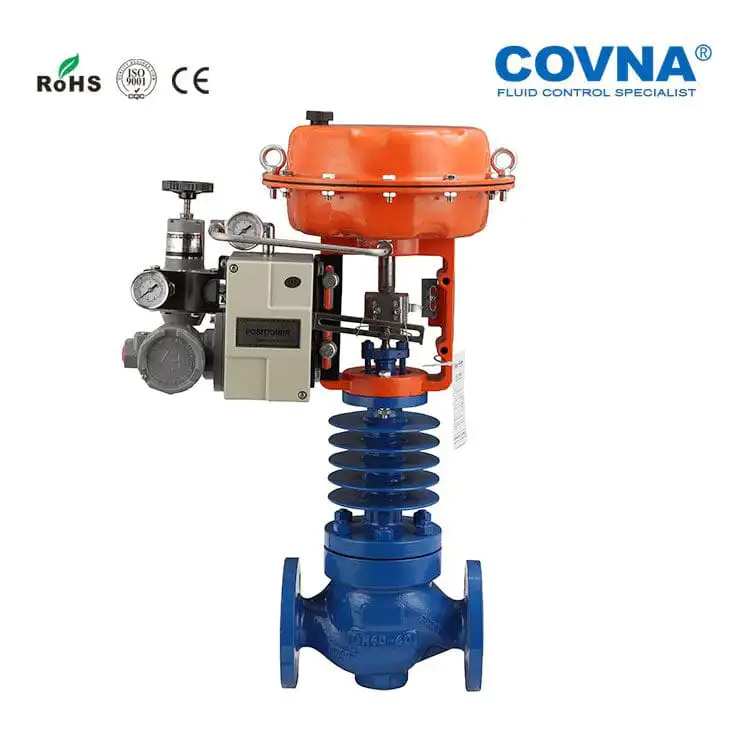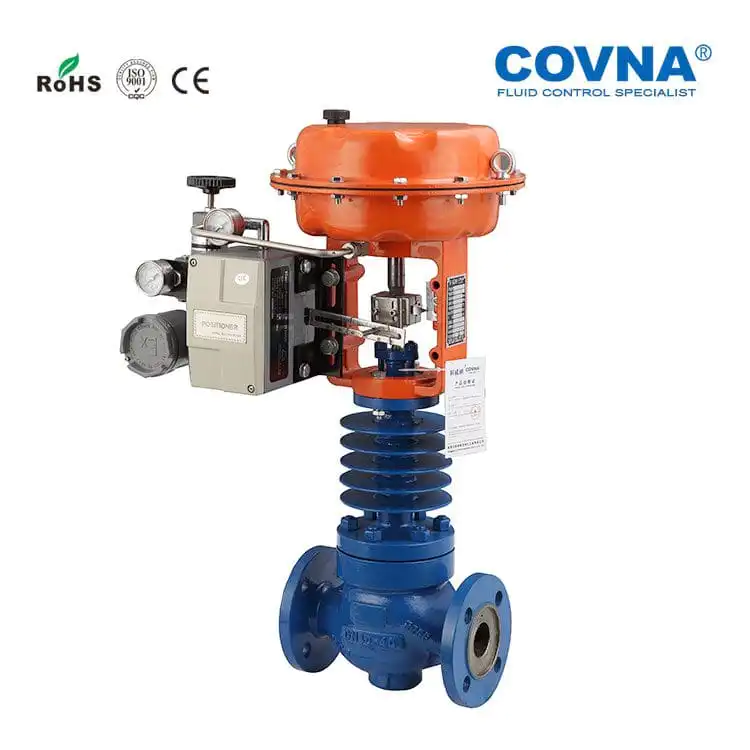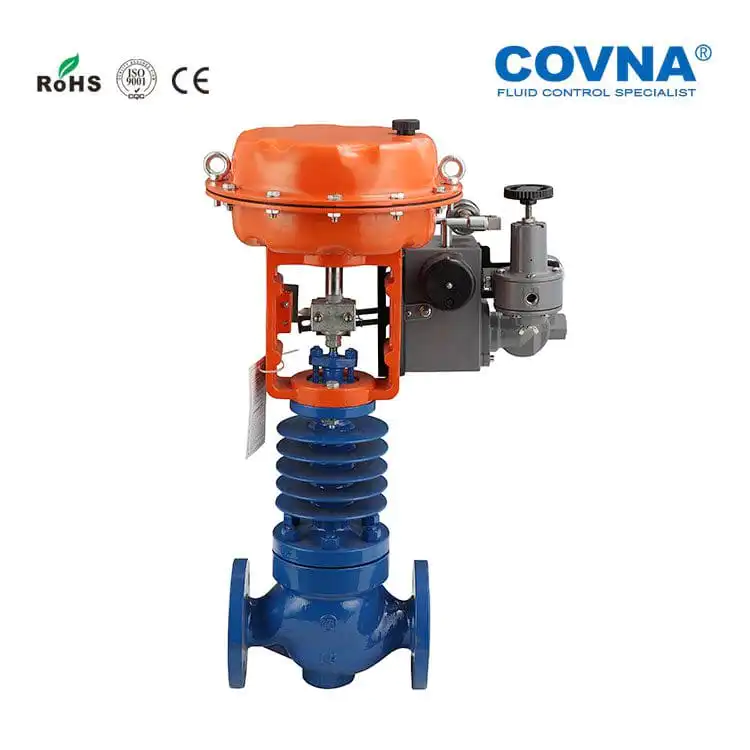COVNA Products



ZJHM Series Top Guide Sleeve WCB Pneumatic High Temperature Control Valve
ZJHM Series Top Guide Sleeve WCB Pneumatic High Temperature Control Valve, which is a low flow resistance control valve, multi spring actuator of low height, light weight, simple equipment. High temperature pneumatic control valve flow channel was streamlined S, the control valve has the advantages of compact structure, light weight, flexible action, small pressure drop loss, valve capacity, flow characteristics of precision, convenient maintenance, High temperature pneumatic control valve regulating mechanism adopts balanced valve plug valve structure, has good stability, not easy to vibration, low noise the temperature sensitivity, small. High temperature pneumatic control valve is especially suitable for leakage requirements is not high, high temperature.
Port size:DN15-DN300
Pressure:PN10-PN64 CL150-CL600
Medium:Water,steam,oil,etc.
Temperature :100~450℃
Body material:WCB,WC6,WC9,CF8,CF8M,etc.
Advantages of ZJHM Series Top Guide Sleeve WCB Pneumatic High Temperature Control Valve:
● It is cost-effective and safe to be used,which can help you save cost of the whole system and maintenance.
● It has a simple structure and a big torque, explosion-proof with short actuating times,optimized actuating forces and reliable tight sealing.
● It can perfectly avoid problems of friction, corrosion, and emissions.
● It is of low center of gravity, high vibration resistance and easy to install.
● Simple to control, rapid response, and intrinsic safety, no need to take additional explosion-proof measures.
● Fluid channels in a s- shaped streamline, small pressure drop loss large flow, wide adjustment range, high precision flow.
● Especially suitable for leakage requirements is not high, high temperature
Working Principle Of high temperature Pneumatic control valve
By receiving the control signal pressure output by the standard electric signals of the regulator(via electricity-air positioner or electricity-air converter),the valve
opening is changed, so as to change the flow of the medium to be regulated and then allow parameters such as flow, pressure,temperature and liquid level to be regulated. As a result, the production process automation is achieved.
After the extraneous pneumatic pressure signal is input into the diaphragm chamber, it will act on the diaphragm to produce a thrust. The thrust then compress the spring pack, and move the push rod, which drives the spindle to open (close) of the valve clack, until the balance is achieved between the thrust and reaction ofthe compressed spring pack and the clack is in a stable position of the stroke.It's concluded from above principle, There's a definite proportional relation between the clack and the input pressure signal.
Technical Parameters of Valve Actuator :
| Nominal Size DN (mm) | 20 | 25 | 32 | 40 | 50 | 65 | 80 | 100 | 125 | 150 | 200 | 250 | 300 | ||||
| 10 | 12 | 15 | 20 | ||||||||||||||
| Rated Flow Coefficient CV | High accuracy flow characteristic clack | 1.6 | 2.5 | 4.0 | 6.3 | 10 | 17 | 24 | 44 | 68 | 99 | 175 | 275 | 360 | 630 | 900 | 1440 |
| High capacity flow characteristic clack | 1.8 | 2.8 | 4.4 | 6.9 | 11 | 21 | 30 | 50 | 85 | 125 | 200 | 310 | 440 | 690 | 1000 | 1600 | |
| Rated Stroke(mm) | 10 | 16 | 25 | 40 | 60 | 100 | |||||||||||
| Effective Diaphragm Area cm2 | 280 | 400 | 630 | 1000 | 1600 | ||||||||||||
| Inherent Regulation Ratio | 50:1 | ||||||||||||||||
| Nominal Pressure MPa | 1.6 / 4.0 / 6.4 | ||||||||||||||||
| Sevice Temperature | -100~-60℃; -200~-100℃; -250~-200℃ | ||||||||||||||||
| Ambient Temperature | -30~70℃ | ||||||||||||||||
| Air Supply Pressure KPa | 0.14 / 0.25 / 0.40 | ||||||||||||||||
| Spring Range KPa | 20~100(Basic type) / 40~200 / 80~240 | ||||||||||||||||
| Connection Thread | G1/4" , M16X1.5 | ||||||||||||||||
Performance of High Temperature Pneumatic Control Valve:
| High temperature pneumatic control valve Flow characteristic |
Linear, percentage, quick open | |
| Allowable range | 50: 1 (CV<6.3 30: 1) | |
| Rated Cv value | Percentage CV1.6~630 ,linear CV1.8~690 | |
| Pneumatic control valve Allowable leakage | Metal seal: IV grade(0.01% rated capacity) Leakage standard: GB/T 4213 |
|
| High temperature pneumatic control valve Performance | ||
| Intrinsic error % | ±1.5 | |
| Return difference, % | ≤1.5 | |
| Dead zone, % | ≤0.6 | |
| Difference from beginning to end point, % | ±2.5 | |
| Rated travel difference, % | ≤2.5 | |
Dimension of ZJH Series Pneumatic Diaphragm Control Globe Valve:

Weight table of Pneumatic diaphragm regulating valve

Company Profile:
Factory Profile:
Company Certificates:
Package & Shipping:
As a professional electric ball valve manufacturer, COVNA aims to provide our customers the best quality products with the most competitive pricing, on-time delivery and full warranty service with omprehensive service from start to finish, encompassing consultation through to after sales service, full support in every respect and ensure that you are accompanied at each stage of your project.
●22 years manufacturer of actuated valves
●Mass customaztion acceptable. 3 production base, large stock,
●Short lead time, same day shipping.
●German imported manufacturing facilities, 100% Q.C passed before shipping, quality assured.
●Industrial standard 1 year (12 months) warranty.
●ISO 9001 certificated, with extra certifications include CE, TUV, RoHS, SGS, BV, explosion & fire safe.
●OEM / ODM service available. Can do JIS 5K / 10K, ANSI 150lb / 300lb / 600lb / 900lb standard.
●More infomation, pls send message to us. Quote will be provided within 2 hours!
Technical Parameter of Actuators:
| Nominal Diameter | G 3/4″ | 20 | 25 | 40 | 50 | 65 | 80 | 100 | 150 | 200 | 250 | 300 | |||||||||||||||||||
| Valve Seat Diameter | 3 4 5 6 7 8 | 10 | 12 | 15 | 20 | 20 | 25 | 25 | 32 | 40 | 32 | 40 | 50 | 40 | 50 | 65 | 50 | 65 | 80 | 65 | 80 | 100 | 100 | 125 | 150 | 125 | 150 | 200 | |||
| Rated Flow Coefficient Cv | High Accuracy Flow Characteristic Clack | 0.08 0.12 0.20 0.32 0.50 0.80 | 1.8 | 2.8 | 4.4 | 6.9 | 6.9 | 11 | 11 | 17.6 | 27.5 | 17.6 | 27.5 | 44 | 27.5 | 44 | 69 | 44 | 69 | 110 | 69 | 110 | 176 | 176 | 275 | 440 | 275 | 440 | 690 | 1000 | 1600 |
| High Capacity Flow Characteristic Clack | 1.6 | 2.5 | 4 | 6.3 | 6.3 | 10 | 10 | 16 | 25 | 16 | 25 | 40 | 25 | 40 | 63 | 40 | 63 | 100 | 63 | 100 | 160 | 160 | 250 | 400 | 250 | 400 | 630 | 900 | 1440 | ||
| Rated Strock(mm) | 10 | 16 | 25 | 40 | 60 | 100 | |||||||||||||||||||||||||
| Effective Diaphragm Area (cm2) | 220 | 350 | 560 | 900 | 1400 | ||||||||||||||||||||||||||
| Inherent Regualtion Ratio | 50:1 | ||||||||||||||||||||||||||||||
| Nominal Pressure MPa | 0.16 1.6 4.0 6.4 (ANSI125 150 300 600LB)(JIS10 16 20 30 40K) | ||||||||||||||||||||||||||||||
| Sevice Temperature | -20 to 200℃ -40 to 250℃ -40 to 450℃ -60 to 450℃ | ||||||||||||||||||||||||||||||
| Ambient Temperature | -40 to 85℃ | ||||||||||||||||||||||||||||||
| Air Supply Pressure KPa | 0.14(0.25 0.4) | ||||||||||||||||||||||||||||||
| Spring Range KPa | 20 to 100(40 t o200 80 to 40 20 to 60 60 to 100) | ||||||||||||||||||||||||||||||
| Connection Threaded | Female Thread M10×1 | ||||||||||||||||||||||||||||||
The actuator on my automated valve operates, but the valve won’t turn. Why?
Most likely the valve stem or actuator coupling is broken.
Why doesn’t my valve open or close completely when the actuator operates it?
The electric actuator limit switches or the pneumatic actuator position stops are not correctly adjusted.
When I energize the solenoid on my pneumatic actuated valve, the valve won’t turn. How come?
Probably because there is no air pressure to the solenoid or dirt has jammed it. Also, debris might be trapped inside the valve. Or, the air pressure is not sufficient to operate the actuator. Remember: measure air pressure at the actuator, not at the compressor.
Can I buy an actuator from one manufacturer and mount it to a valve from another manufacturer?
Maybe. First, be sure that the actuator torque output is sufficient to turn the valve reliably. Second, you will have to fabricate a custom mounting bracket and coupling to connect the actuator to the valve.
What happens if I lose power to my electric actuator in the middle of an actuation cycle?
The valve will stop somewhere between full open and close. When power is reapplied to the original circuit, the actuator will complete the cycle.
I ordered a fail open pneumatic actuated valve by mistake. I needed a fail closed one. What can I do?
To make the change just remove the actuator from the valve and turn it, or the valve stem, 90 degrees and remount the actuator.
I’ve installed my automated valve in the line, but now I don’t know if the valve is in the open or closed position. How can I find out?
Remove the actuator from the valve and check the valve stem. Most ball valves have stem flats at right angles to the flow when the valve is in the off position. On butterfly valves check the stem flow arrow marking.
Do I have to have the solenoid valve that controls the air supply to my pneumatic actuator mounted right on the actuator?
Remove the actuator from the valve and check the valve stem. Most ball valves have stem flats at right angles to the flow when the valve is in the off position. On butterfly valves check the stem flow arrow marking.
How do I wire up my electric actuator?
Check the electric wiring schematic that came with the actuator for the correct hookup. Sometimes a copy is inside the actuator cover. If it is missing, don’t guess about the connections. Call the manufacturer for a schematic.
I’ve just installed an electric actuated valve and when I power it, it turns the valve 360 degrees and won’t shut off. What’s wrong?
The actuator is wired incorrectly (check the schematic accompanying the actuator), or the external control switch is not the correct type for the actuator.
My electric actuators cycle time is way too fast, can I slow it down?
Not unless you bought it with an optional speed control.
I just replaced a solenoid valve with an electric actuated valve and it won’t work. Why?
Actuators and solenoid valves require different types of electrical control switches. SPDT for actuators, SPST for solenoids. Check the actuator wiring schematic for the correct wiring and switch type.







_2022_03(1).png)




(1).png)











